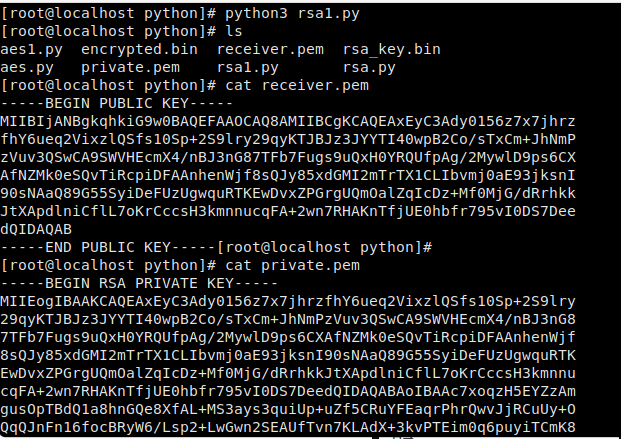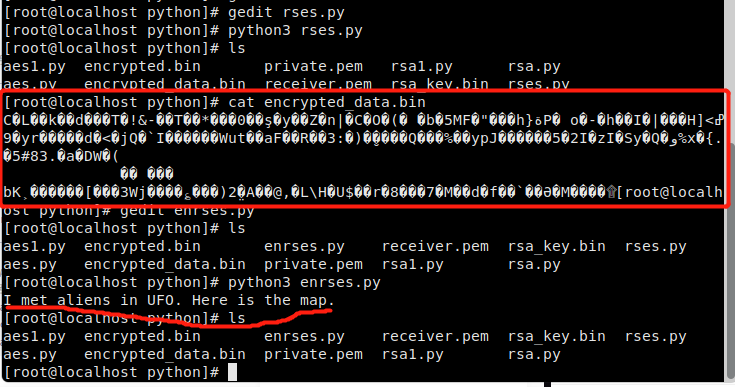python实现密码算法
python通过Cryptodome使用AES加密数据
from Crypto.Cipher import AES
from Crypto.Random import get_random_bytes
data = b'secret data'
key = get_random_bytes(16)
cipher = AES.new(key, AES.MODE_EAX)
ciphertext, tag = cipher.encrypt_and_digest(data)
file_out = open("encrypted.bin", "wb")
[ file_out.write(x) for x in (cipher.nonce, tag, ciphertext) ]
file_out.close()
file_in = open("encrypted.bin", "rb")
nonce, tag, ciphertext = [ file_in.read(x) for x in (16, 16, -1) ]
# let's assume that the key is somehow available again
cipher = AES.new(key, AES.MODE_EAX, nonce)
data = cipher.decrypt_and_verify(ciphertext, tag)
print(data)

生成RSA密钥
from Crypto.PublicKey import RSA
#对密钥加密的密码
secret_code = "Unguessable"
#生成一个 2048 位的密钥
key = RSA.generate(2048)
#导出私钥,passphrase 指定了对私钥加密的密码
encrypted_key = key.export_key(passphrase=secret_code, pkcs=8,
protection="scryptAndAES128-CBC")
#将私钥保存到文件
file_out = open("rsa_key.bin","wb")
file_out.write(encrypted_key)
file_out.close()
#输出公钥
print(key.publickey().export_key())


生成公钥和私钥
生成了私钥并保存到private.pem,之后生成了公钥,保存为receiver.pem
from Crypto.PublicKey import RSA
#生成密钥
key = RSA.generate(2048)
#保存私钥
private_key = key.export_key()
file_out = open("private.pem", "wb")
file_out.write(private_key)
file_out.close()
#保存公钥
public_key = key.publickey().export_key()
file_out = open("receiver.pem", "wb")
file_out.write(public_key)
file_out.close()

RSA + AES混合加密
为了加密任意数量的数据,这里使用混合加密方式(RSA+AES)。这里使用 RSA 和 PKCS#1oaep 对 AES 会话密钥进行非对称加密
from Crypto.PublicKey import RSA
from Crypto.Random import get_random_bytes
from Crypto.Cipher import AES, PKCS1_OAEP
#要加密的数据
data = "I met aliens in UFO. Here is the map.".encode("utf-8")
#加密数据的输出
file_out = open("encrypted_data.bin", "wb")
#读取公钥
recipient_key = RSA.import_key(open("receiver.pem").read())
session_key = get_random_bytes(16)
# Encrypt the session key with the public RSA key
#加密会话密钥
cipher_rsa = PKCS1_OAEP.new(recipient_key)
enc_session_key = cipher_rsa.encrypt(session_key)
# Encrypt the data with the AES session key
#利用 AES 会话密钥加密数据
cipher_aes = AES.new(session_key, AES.MODE_EAX)
ciphertext, tag = cipher_aes.encrypt_and_digest(data)
[ file_out.write(x) for x in (enc_session_key, cipher_aes.nonce, tag, ciphertext) ]
file_out.close()
对于拥有私钥的解密者,首先使用私钥对会话密钥进行解密,再用会话密钥解密文件:
from Crypto.PublicKey import RSA
from Crypto.Cipher import AES, PKCS1_OAEP
file_in = open("encrypted_data.bin", "rb")
#导入私钥
private_key = RSA.import_key(open("private.pem").read())
#读取 AES 的相关参数
enc_session_key, nonce, tag, ciphertext = \
[ file_in.read(x) for x in (private_key.size_in_bytes(), 16, 16, -1) ]
# Decrypt the session key with the private RSA key
# 对会话密钥解密
cipher_rsa = PKCS1_OAEP.new(private_key)
session_key = cipher_rsa.decrypt(enc_session_key)
# Decrypt the data with the AES session key
#使用会话密钥解密数据
cipher_aes = AES.new(session_key, AES.MODE_EAX, nonce)
data = cipher_aes.decrypt_and_verify(ciphertext, tag)
print(data.decode("utf-8"))

安装gmssl(pip install gmssl)和pysmx(pip install snowland-smx)
python实现sm4
通过gmssl
##############################################################################
# #
# 国产SM4加密算法 #
# #
##############################################################################
import binascii
from gmssl import sm4
class SM4:
"""
国产加密 sm4加解密
"""
def __init__(self):
self.crypt_sm4 = sm4.CryptSM4() # 实例化
def str_to_hexStr(self, hex_str):
"""
字符串转hex
:param hex_str: 字符串
:return: hex
"""
hex_data = hex_str.encode('utf-8')
str_bin = binascii.unhexlify(hex_data)
return str_bin.decode('utf-8')
def encryptSM4(self, encrypt_key, value):
"""
国密sm4加密
:param encrypt_key: sm4加密key
:param value: 待加密的字符串
:return: sm4加密后的十六进制值
"""
crypt_sm4 = self.crypt_sm4
crypt_sm4.set_key(encrypt_key.encode(), sm4.SM4_ENCRYPT) # 设置密钥
date_str = str(value)
encrypt_value = crypt_sm4.crypt_ecb(date_str.encode()) # 开始加密。bytes类型
return encrypt_value.hex() # 返回十六进制值
def decryptSM4(self, decrypt_key, encrypt_value):
"""
国密sm4解密
:param decrypt_key:sm4加密key
:param encrypt_value: 待解密的十六进制值
:return: 原字符串
"""
crypt_sm4 = self.crypt_sm4
crypt_sm4.set_key(decrypt_key.encode(), sm4.SM4_DECRYPT) # 设置密钥
decrypt_value = crypt_sm4.crypt_ecb(bytes.fromhex(encrypt_value)) # 开始解密。十六进制类型
return decrypt_value.decode()
# return self.str_to_hexStr(decrypt_value.hex())
if __name__ == '__main__':
key = "f38fc9b32af486e65d6f93dbc41b9123"
strData = "90897h8789thvht"
SM4 = SM4()
print("原字符:", strData)
encData = SM4.encryptSM4(key, strData) # 加密后的数据,返回bytes类型
print("sm4加密结果:", encData)
decData = SM4.decryptSM4(key, encData)
print("sm4解密结果:", decData) # 解密后的数据

python通过gmssl实现sm2
import sys
from gmssl import sm2
from base64 import b64encode, b64decode
# sm2的公私钥
SM2_PRIVATE_KEY = '00B9AB0B828FF68872F21A837FC303668428DEA11DCD1B24429D0C99E24EED83D5'
SM2_PUBLIC_KEY = 'B9C9A6E04E9C91F7BA880429273747D7EF5DDEB0BB2FF6317EB00BEF331A83081A6994B8993F3F5D6EADDDB81872266C87C018FB4162F5AF347B483E24620207'
sm2_crypt = sm2.CryptSM2(public_key=SM2_PUBLIC_KEY, private_key=SM2_PRIVATE_KEY)
# 加密
def encrypt(info):
encode_info = sm2_crypt.encrypt(info.encode(encoding="utf-8"))
encode_info = b64encode(encode_info).decode() # 将二进制bytes通过base64编码
return encode_info
# 解密
def decrypt(info):
decode_info = b64decode(info.encode()) # 通过base64解码成二进制bytes
decode_info = sm2_crypt.decrypt(info).decode(encoding="utf-8")
return decode_info
if __name__ == "__main__":
action = sys.argv[1] # 取命令中的加解密动作
contact_info = sys.argv[2] # 取命令中需要加解密的内容
if action == "encrypt":
encrypted_contact_info = encrypt(contact_info)
print(encrypted_contact_info)
if action == "decrypt":
decrypted_contact_info = decrypt(contact_info)
print(decrypted_contact_info)
from gmssl import sm2
# sm2的公私钥
SM2_PRIVATE_KEY = '00B9AB0B828FF68872F21A837FC303668428DEA11DCD1B24429D0C99E24EED83D5'
SM2_PUBLIC_KEY = 'B9C9A6E04E9C91F7BA880429273747D7EF5DDEB0BB2FF6317EB00BEF331A83081A6994B8993F3F5D6EADDDB81872266C87C018FB4162F5AF347B483E24620207'
sm2_crypt = sm2.CryptSM2(public_key=SM2_PUBLIC_KEY, private_key=SM2_PRIVATE_KEY)
# 加密
def encrypt(info):
encode_info = sm2_crypt.encrypt(info.encode(encoding="utf-8"))
return encode_info
# 解密
def decrypt(info):
decode_info = sm2_crypt.decrypt(info).decode(encoding="utf-8")
return decode_info
if __name__ == "__main__":
info = "123456"
encode_info = encrypt(info)
print(encode_info)
decode_info = decrypt(encode_info)
print(decode_info)
from gmssl import sm2
# sm2的公私钥
SM2_PRIVATE_KEY = '00B9AB0B828FF68872F21A837FC303668428DEA11DCD1B24429D0C99E24EED83D5'
SM2_PUBLIC_KEY = 'B9C9A6E04E9C91F7BA880429273747D7EF5DDEB0BB2FF6317EB00BEF331A83081A6994B8993F3F5D6EADDDB81872266C87C018FB4162F5AF347B483E24620207'
sm2_crypt = sm2.CryptSM2(public_key=SM2_PUBLIC_KEY, private_key=SM2_PRIVATE_KEY)
# 加密
def encrypt(info):
encode_info = sm2_crypt.encrypt(info.encode(encoding="utf-8"))
return encode_info
# 解密
def decrypt(info):
decode_info = sm2_crypt.decrypt(info).decode(encoding="utf-8")
return decode_info
if __name__ == "__main__":
info = "123456"
encode_info = encrypt(info)
print(encode_info)
decode_info = decrypt(encode_info)
print(decode_info)




 浙公网安备 33010602011771号
浙公网安备 33010602011771号